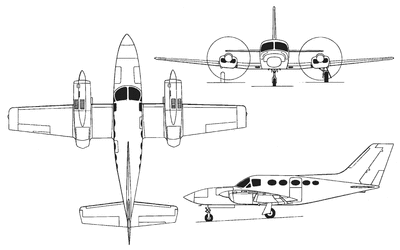Family Of Seven Fatally Injured When Airplane When Cessna 421
Went Down After Declaring An Emergency
 The NTSB is looking at a possible
engine failure in an accident July 9th which fatally injured all
seven people aboard a Cessna 421C. The pilot reported engine
problems while in cruise flight at FL210, and an examination of the
engine found damage on the camshaft gear teeth of the airplane's
right engine.
The NTSB is looking at a possible
engine failure in an accident July 9th which fatally injured all
seven people aboard a Cessna 421C. The pilot reported engine
problems while in cruise flight at FL210, and an examination of the
engine found damage on the camshaft gear teeth of the airplane's
right engine.
NTSB Identification: ERA11FA391
14 CFR Part 91: General Aviation
Accident occurred Saturday, July 09, 2011 in Demopolis, AL
Aircraft: CESSNA 421C, registration: N692TT
Injuries: 7 Fatal.
This is preliminary information, subject to change, and may
contain errors. Any errors in this report will be corrected when
the final report has been completed.
On July 9, 2011, about 1740 central daylight time, a Cessna
421C, N629TT, operated by a private individual, was substantially
damaged when it impacted terrain while on approach to the Demopolis
Municipal Airport (DYA), Demopolis, Alabama. The certificated
private pilot and six passengers were fatally injured. Visual
meteorological conditions prevailed and an instrument flight rules
flight plan was filed for the flight that departed the Creve Coeur
Airport (1H0), St. Louis, Missouri, destined for the Destin-Ft.
Walton Beach Airport (DTS), Destin, Florida. The personal flight
was conducted under the provisions of Title 14 Code of Federal
Regulations Part 91.
The airplane was based at DTS, and owned by the pilot through a
limited liability company. According to witnesses, the pilot, his
wife, and five children departed from 1H0 about 1520. According to
preliminary information obtained from the FAA, the pilot was in
cruise flight at flight level 210 (21,000 feet), and in contact
with the Atlanta air route traffic control center when he declared
an emergency due to a rough running engine. He diverted to DYA,
which was located 12 o'clock and 5 miles from the airplane's
position. The pilot was switched to Meridian Approach while
descending through 17,500 feet. He subsequently confirmed that he
had shut down the right engine and reported the airport in sight.
The pilot was cleared for a visual approach and then approved for a
frequency change to the local common traffic advisory frequency,
when the airplane was about 3 miles east of the airport. There were
no further communications received from the airplane. The
airplane's radar track was consistent with an approach to runway
22, a 5,002-foot-long, 100-foot-wide, asphalt runway, when radar
contact was lost at 1739, at an altitude of 800 feet.

The airplane impacted trees in a wooded area, about .8 miles
north of the runway 22 threshold. The airplane came to rest
inverted, in a flat attitude, on a course of about 100 degrees. The
cockpit, the cabin 40-inches forward of the tail cone, and the left
wing were consumed by fire. A series of tree strikes were observed
about 50 feet above the ground, approximately 70 feet south of the
main wreckage. All major portions of the airplane were accounted
for at the accident site. There was no longitudinal deformation of
the fuselage noted. The radar dome was observed installed and
retained its shape. All three landing gear actuators were observed
in the extended position. Portions of the flaps that were not
compromised due to fire and or impact damage were extended
approximately 40 degrees.
The entire right wing was separated at the root and came to rest
against a tree adjacent to the main wreckage. The right engine
propeller was observed at or near a feathered position. The left
engine and propeller were fire damaged. Initial examination of the
airframe and the left engine assembly did not reveal any
catastrophic inflight mechanical failures; however, during initial
examination of the right engine assembly, after the right engine
fuel pump was removed, significant damage was observed on the
camshaft gear teeth.
The wreckage, including both engines and propellers was retained
for further examination. Initial review of maintenance records
revealed that airplane's most recent annual inspection was
performed on January 19, 2011.
 ANN's Daily Aero-Linx (04.13.24)
ANN's Daily Aero-Linx (04.13.24) ANN's Daily Aero-Term (04.13.24): Beyond Visual Line Of Sight (BVLOS)
ANN's Daily Aero-Term (04.13.24): Beyond Visual Line Of Sight (BVLOS) Airborne 04.09.24: SnF24!, Piper-DeltaHawk!, Fisher Update, Junkers
Airborne 04.09.24: SnF24!, Piper-DeltaHawk!, Fisher Update, Junkers Aero-News: Quote of the Day (04.14.24)
Aero-News: Quote of the Day (04.14.24) ANN's Daily Aero-Term (04.14.24): Maximum Authorized Altitude
ANN's Daily Aero-Term (04.14.24): Maximum Authorized Altitude




